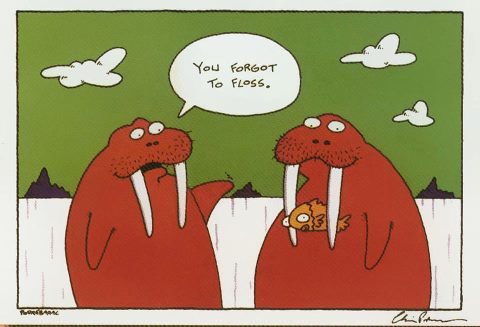How to Floss

Taking care of your teeth is an important aspect of personal hygiene. Many people have a regular routine of waking up, brushing their teeth, taking a shower, and getting ready for the day yet few people know that by skipping a daily floss, they’re leaving up to 40% of their mouth unclean. By not flossing, you increase the chance of tooth decay, cavities, tooth aches, and even tooth loss.
Flossing, or Interdental Cleaning as it’s officially called, is the act of taking a piece of string and moving it between the teeth to remove food or other particles that become wedged in that space between the teeth and the gums. Interdental cleaning could also be done by using other tools like toothpicks, waterpicks, or those toothpicks with brushes that are called “Brushpicks”, but the general idea is to use some thing to get the food lodged between your teeth out so that the bacteria doesn’t turn in to plaque and plaque doesn’t turn in to tartar.
Is Flossing Really Beneficial?
Recently there has been a train of thought stating that daily flossing really isn’t necessary. A few years ago, the New York Times published an article that said flossing may not be necessary after all. They backed up their statement by saying that there really hasn’t been much research to back up the causation that regular interdental cleaning (flossing) leads to less cavities or better gum health. However, the American Dental Association states that they have studies to back up the claim that flossing really is beneficial.
A meta-analysis of studies examining the impact of flossing on interproximal caries, found that regular (5 days per week) professional flossing resulted in a statistically significant reduction in interproximal caries, a result that was not seen with intermittent (every 3 months) professional flossing nor self-flossing.
https://www.ada.org/en/science-research/science-in-the-news/the-medical-benefit-of-daily-flossing-called-into-question
What they’re saying is that for people who floss 5 days a week, the number cavities was much lower with those that only floss once every 3 months. So the evidence is clear, if you floss regularly you will likely have less cavities than someone who only flosses when they have to.
Steps to Proper Flossing
So now you know that flossing is good for you, you should now get in the habit of flossing daily! This will help you achieve your best smile, reduce bad breath, lower your chances of getting cavities, and keep your gums healthy.
- Pick a dental floss that works for you.
- There are a few different types of dental floss available with different flavors, Start out with a thin strand a a neutral flavor unless you know you like a specific one, then go for it!
- Use about 18 inches of floss, wound around one of your middle fingers, with the rest wound around the opposite middle finger.
- Starting between your lower right and lower left central teeth, gently wiggle the floss until it reaches your gums and gently clean between the teeth.
- It is important to move gently so as to not irritate the gums or hurt yourself.
- Move to the next tooth on the bottom of your mouth until the teeth in that quarter of your mouth are cleaned.
- Move to the other side in the bottom of your mouth and floss between each teeth.
- Starting between the upper right and upper left central teeth, repeat steps 3 and 4 at the top of your mouth.
Flossing can be a little time consuming at first, but overall, it’s a small time commitment compared to scheduling a dentist visit and sitting on the chair while they work on your teeth to fix them up. The American Dental Association recommends that you floss every day, so find a time that works best for you and stick to it.
During your next dentist visit, talk to your dentist about the right flossing solution for your teeth if you are unsure about your product or techniques. They’ll be happy to point you in the right direction!
